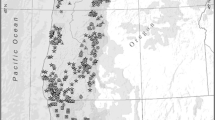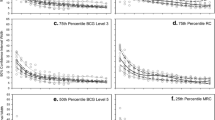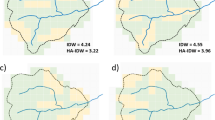Abstract
Field assessments of impacted streams require a control or at least an unbiased estimate of attainable conditions. Control sites, such as upstream/downstream or wilderness sites, have proven inadequate for assessing attainable ecological conditions where the control streams differ naturally from the impacted streams to a considerable degree or where different disturbances exist than those being studied. Relatively undisturbed reference sites with watersheds in areas having the same land-surface form, soil, potential natural vegetation, and land use as are predominant in large, relatively homogeneous regions are suggested as alternative control sites. These areas are considered typical of the region and therefore the sites also are considered typical of the region because their watersheds exhibit all the terrestrial variables that make that region a region. The logical basis for developing regional reference sites lies in the ability to group watersheds and common stream types into regions by integrating available maps of terrestrial variables that influence streams. Relatively undisturbed reference sites can be selected from typical areas of the regions and from transition zones where one or two of the terrestrial variables are not the predominant one(s) of the region. These reference sites are useful for estimating attainable conditions, for evaluating temporal and spatial changes in ecological integrity, for classifying attainable uses of streams, and for setting biological and environmental criteria.
Similar content being viewed by others
Literature cited
Bailey, R. G. 1983. Delineation of ecosystem regions.Environmental Management 7:365–373.
Brussock, P. P., A. V. Brown, J. C. Dixon. 1985. Channel form and stream ecosystem models.Water Resources Bulletin 21:859–866.
Federal Register. 1982. Proposed water quality standards and public meetings. 47:49234–49252.
Giattina, J. D. 1985. Watershed-aquatic habitat-aquatic biota interrelationships in a western Oregon river. Unpublished.
Hall, J. D., M. L. Murphy, and R. S. Aho. 1978. An improved design for assessing impacts of watershed practices on small streams.Proceedings of the International Association of Theoretical and Applied Limnology 20:1359–1365.
Hanski, I. 1982. Dynamics of regional distribution: the core and satellite species hypothesis.Oikos 38:210–221.
Hart, J. F. 1982. The highest form of the geographer's art.Annals of the Association of American Geographers 72:1–29.
Hughes, R. M. 1985. Use of watershed characteristics to select control streams for estimating effects of metal mining wastes on extensively disturbed streams.Environmental Management 9:253–262.
Hughes, R. M., and J. M. Omernik. 1983. An alternative for characterizing stream size. Pages 87–101in T. D. Fontaine III and S. M. Bartell (eds.), Dynamics of lotie ecosystems. Ann Arbor Science, Ann Arbor, Michigan.
Hynes, H. B. N. 1975. The stream and its valley.Proceedings of the International Association of Theoretical and Applied Limnology 19:1–15.
Illies, J., and L. Botosaneanu. 1963. Problèmes et méthodes de la classification et de la zonation écologique des eaux courantes, considerées sûrtout du point de vue faunistique.Communications from the International Association of Theoretical and Applied Limnology 12:1–57.
Jarman, R. 1984. The development of aquatic ecoregions in Oklahoma. PhD dissertation, University of Oklahoma, Norman, 196 pp.
Karr, J. R., and D. R. Dudley. 1981. Ecological perspective on water quality goals.Environmental Management 5:55–68.
Karr, J. R., R. C. Heidinger, and E. H. Helmer. 1985. Effects of chlorine and ammonia from wastewater treatment facilities on biotic integrity.Journal of the Water Pollution Control Federation 57:912–915.
Larsen, D. P., R. M. Hughes, J. M. Omernik, D. R. Dudley, C. M. Rohm, T. R. Whittier, A. J. Kinney, and A. L. Gallant. 1986. The correspondence between spatial patterns in fish assemblages in Ohio streams and aquatic ecoregions.Environmental Management 10 (in press).
Likens, G. E., and F. H. Bormann. 1974. Linkages between aquatic and terrestrial ecosystems.Bioscience 21:447–456.
Marsh, P. C., and J. E. Luey. 1982. Oases for aquatic life in agricultural watersheds.Fisheries 7:16–24.
Matthews, W. J. 1985. Distribution of midwestern fishes on multivariate environmental gradients, with emphasis onNotropis lutrensis.American Midland Naturalist 113:225–237.
Miller, A. 1985. Technological thinking: its impact on environmental management.Environmental Management 9:179–190.
Omernik, J. M. 1985. Aquatic ecoregions of the conterminous United States (text and map).Annals of the Association of American Geographers (submitted for publication).
Pennak, R. W. 1971. Toward a classification of lotic habitats.Hydrobiologia 38:321–334.
Petak, W. 1980. Environmental planning and management: the need for an integrative perspective.Environmental Management 4:287–295.
Pfleiger, W. L., M. A. Schene, and P. S. Haverland. 1981. Techniques for the classification of stream habitats, with examples of their application in defining the stream habitats of Missouri. Pages 362–368in N. B. Armantrout (ed.), Acquisition and utilization of aquatic habitat inventory information. American Fisheries Society, Bethesda, Maryland.
Richards, K. 1982. Rivers: form and process in alluvial channels. Methuen, New York, 358 pp.
Rowe, J. S., and J. W. Sheard. 1981. Ecological land classification: a survey approach.Environmental Management 5:451–464.
Shirazi, M. A. 1984. Land classification used to select abandoned hazardous waste study sites.Environmental Management 8:281–286.
Trautman, M. B. 1981. The fishes of Ohio. Ohio State University Press, Columbus, Ohio, 782 pp.
Van Deusen, R. D. 1954. Maryland freshwater stream classification by watersheds.Contributions from the Chesapeake Biological Laboratory 106:1–30.
Vannote, R. L., G. W. Minshall, K. W. Cummins, J. R. Sedell, and C. E. Cushing. 1980. The river continuum concept.Canadian Journal of Fisheries and Aquatic Science 37:130–137.
Warren, C. E. 1979. Toward classification and rationale for watershed management and stream protection. EPA-600/ 3-79-059. US Environmental Protection Agency, Corvallis, Oregon, 143 pp.
Author information
Authors and Affiliations
Rights and permissions
About this article
Cite this article
Hughes, R.M., Larsen, D.P. & Omernik, J.M. Regional reference sites: a method for assessing stream potentials. Environmental Management 10, 629–635 (1986). https://doi.org/10.1007/BF01866767
Issue Date:
DOI: https://doi.org/10.1007/BF01866767




